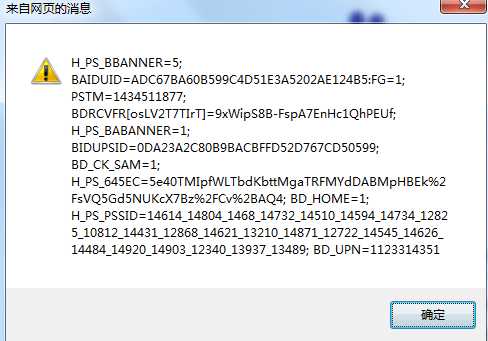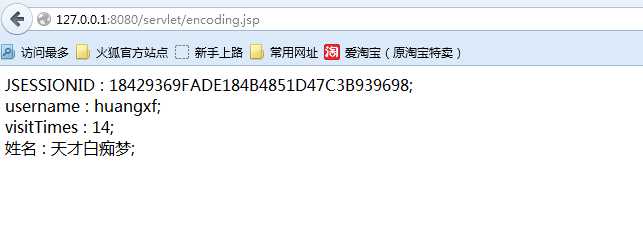标签:
Cookie机制
会话跟踪是Web程序中常用的技术,用来跟踪用户的整个会话。常用的会话跟踪技术是Cookie和Session。Cookie通过在客户端记录信息确定用户身份,Session通过在服务器端记录信息确定用户身份。今天,我首先给大家讲解一下Cookie机制,后面我会给大家提到Session的。
Web应用程序是使用HTTP协议传输数据的。HTTP协议是无状态的协议。一旦数据交换完毕,客户端与服务器端的连接就会关闭,再次交换数据需要新的连接。这就意味着服务器无法从连接上跟踪会话。即用户A购买了一件商品放入购物车内,当再次购买商品时服务器已经无法判断该购买行为是属于用户A的会话还是用户B的会话。所以,要跟踪会话,我们必须引入一种机制。此时,我们就给客户端们颁发一个通行证,无论谁访问都必须出示通行证也就是身份卡。这样服务器就可以通过这个身份卡辨别出身份了。这就是Cookie的工作原理。
我们还可以查看网站颁发的Cookie,只需要在网址栏中输入javascript:alert(document.cookie)就可以了。

Java中把Cookie封装成了javax.servlet.http.Cookie类。每个Cookie都是该Cookie类的对象。服务器通过操作Cookie对象来对客户端Cookie进行操作,通过request.getCookie()获取客户端提交的所有Cookie,通过response.addCookie(Cookie cookie)向客户端设置Cookie。
Cookie对象使用key-value属性对的形式保存用户状态,一个Cookie对象保存一个属性对,一个request或者response同时使用多个Cookie。
以下代码就是使用Cookie来记录用户账号以及登陆次数的例子。
1 <%@ page import="java.util.Date" %> 2 <%@ page import="java.text.SimpleDateFormat" %> 3 <%-- 4 Created by IntelliJ IDEA. 5 User: Administrator 6 Date: 2015/6/17 7 Time: 11:58 8 To change this template use File | Settings | File Templates. 9 --%> 10 <%@ page contentType="text/html;charset=UTF-8" language="java" %> 11 <% 12 request.setCharacterEncoding("UTF-8"); 13 14 String username = ""; 15 int visitTimes = 0; 16 17 Cookie[] cookies = request.getCookies(); 18 19 for (int i = 0; cookies != null && i < cookies.length; i++) { 20 Cookie cookie = cookies[i]; 21 if ("username".equals(cookie.getName())) { 22 username = cookie.getValue(); 23 } else if ("visitTimes".equals(cookie.getName())) { 24 visitTimes = Integer.parseInt(cookie.getValue()); 25 } 26 } 27 if (username == null || username.trim().equals("")) { 28 throw new Exception("请先登录"); 29 } 30 Cookie visitTimesCookie = new Cookie("visitTimes",Integer.toString(++visitTimes)); 31 response.addCookie(visitTimesCookie); 32 %> 33 <html> 34 <head> 35 <title></title> 36 </head> 37 <body> 38 <div align="center" style="margin:10px; "> 39 <fieldset> 40 <legend>登录信息 当前时间:<%= new Date() %></legend> 41 <form action="login.jsp" method="post"> 42 <table> 43 <tr> 44 <td>您的账号: </td> 45 <td><%= username %></td> 46 </tr> 47 <tr> 48 <td>登录次数: </td> 49 <td><%= visitTimes %></td> 50 </tr> 51 <tr> 52 <td></td> 53 <td> 54 <input type="button" value="刷 新" onclick="location=‘<%=request.getRequestURI()%>?ts=‘ + new 55 Date().getTime(); " class="button"> 56 </td> 57 </tr> 58 </table> 59 </form> 60 </fieldset> 61 </div> 62 </body> 63 </html>
如果没有找到包含username属性的Cookie,则抛出异常,页面跳转到登陆页面login.jsp。
1 <%-- 2 Created by IntelliJ IDEA. 3 User: Administrator 4 Date: 2015/6/17 5 Time: 12:14 6 To change this template use File | Settings | File Templates. 7 --%> 8 <%@ page contentType="text/html;charset=UTF-8" language="java" %> 9 <% 10 request.setCharacterEncoding("UTF-8"); 11 response.setCharacterEncoding("UTF-8"); 12 13 if ("POST".equals(request.getMethod())) { 14 Cookie usernameCookie = new Cookie("username",request.getParameter("username")); 15 Cookie visitTimesCookie = new Cookie("visitTimes","0"); 16 17 response.addCookie(usernameCookie); 18 response.addCookie(visitTimesCookie); 19 20 response.sendRedirect(request.getContextPath() + "/cookie.jsp"); 21 return ; 22 } 23 %> 24 <html> 25 <head> 26 <title>请先登录</title> 27 </head> 28 <body> 29 <div align="center" style="margin:10px; "> 30 <fieldset> 31 <legend>登录</legend> 32 <form action="login.jsp" method="post"> 33 <table> 34 <tr> 35 <td>账号: </td> 36 <td><input type="text" name="username" style="width:200px; "></td> 37 </tr> 38 <tr> 39 <td>密码: </td> 40 <td><input type="password" name="password" style="width:200px; "</td> 41 </tr> 42 <tr> 43 <td></td> 44 <td><input type="submit" value="登 录" class="button"</td> 45 </tr> 46 </table> 47 </form> 48 </fieldset> 49 </div> 50 </body> 51 </html>
另外,Cookie还具有以下一些特点:
下面的程序使用UTF-8编码了Cookie内容,然后再使用UTF-8解码Cookie并显示出来。
1 <%-- 2 Created by IntelliJ IDEA. 3 User: Administrator 4 Date: 2015/6/17 5 Time: 13:41 6 To change this template use File | Settings | File Templates. 7 --%> 8 <%@ page contentType="text/html;charset=UTF-8" language="java" %> 9 <jsp:directive.page import="java.net.URLEncoder"/> 10 <jsp:directive.page import="java.net.URLDecoder"/> 11 <% 12 Cookie cookie = new Cookie( 13 URLEncoder.encode("姓名","UTF-8"), 14 URLEncoder.encode("天才白痴梦","UTF-8")); 15 response.addCookie(cookie); 16 %> 17 <html> 18 <head> 19 <title>Cookie Encoding</title> 20 </head> 21 <body> 22 <% 23 if (request.getCookies() != null) { 24 for (Cookie cc : request.getCookies()) { 25 String cookieName = URLDecoder.decode(cc.getName(),"UTF-8"); 26 String cookieValue = URLDecoder.decode(cc.getValue(),"UTF-8"); 27 28 out.println(cookieName + " : " + cookieValue + "; <br/>"); 29 } 30 } 31 else { 32 out.println("Cookie 已经写入客户端,请刷新页面。"); 33 } 34 %> 35 </body> 36 </html>

标签:
原文地址:http://www.cnblogs.com/BaiYiShaoNian/p/4583116.html